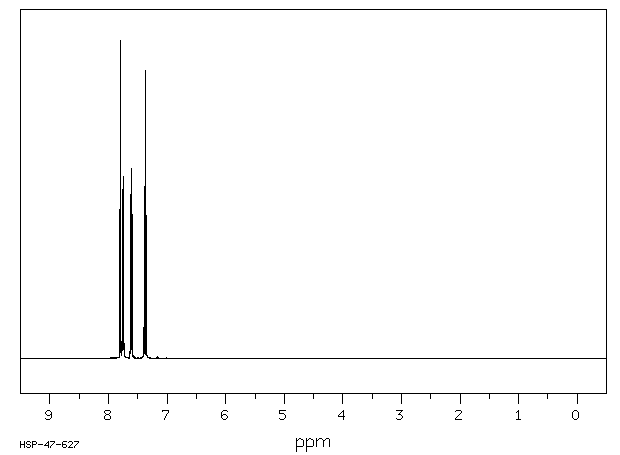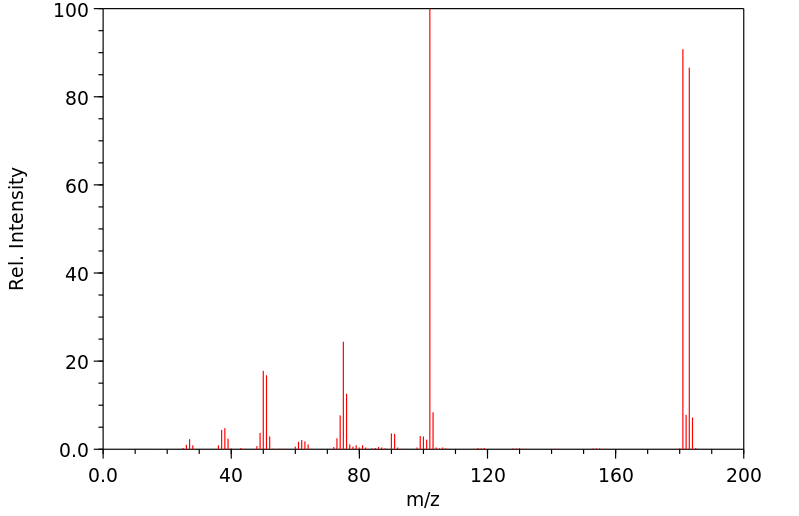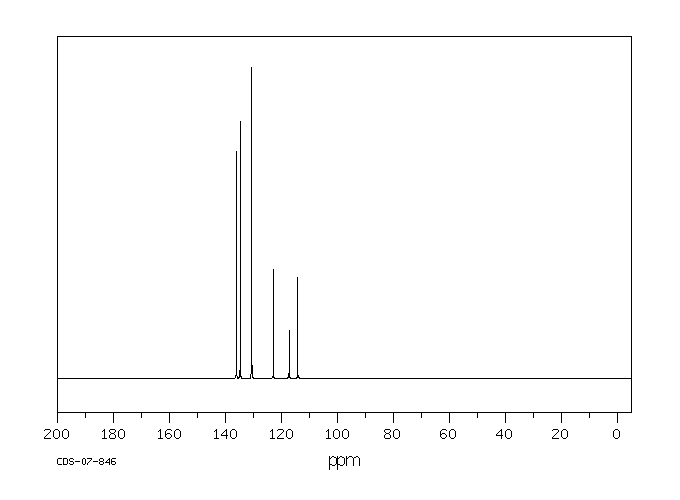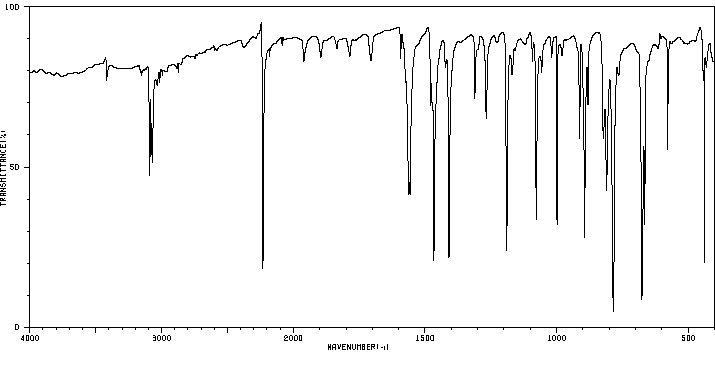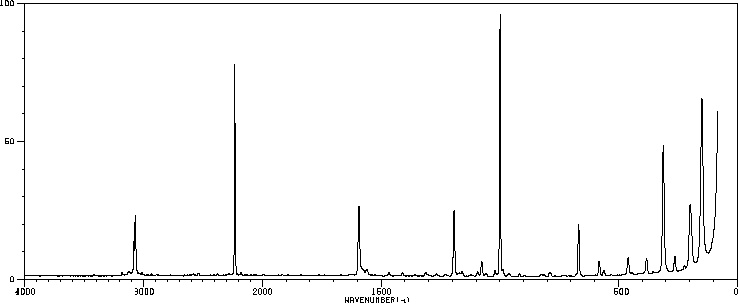间溴苯甲腈 | 6952-59-6
中文名称
间溴苯甲腈
中文别名
间溴苯腈;3-溴苯腈;3-溴苯甲腈;3-溴苄腈;3-溴苯甲腈,99%
英文名称
3-cyanobromobenzene
英文别名
3-Bromobenzonitrile;m-bromobenzonitrile
CAS
6952-59-6
化学式
C7H4BrN
mdl
MFCD00001796
分子量
182.019
InChiKey
STXAVEHFKAXGOX-UHFFFAOYSA-N
BEILSTEIN
——
EINECS
——
-
物化性质
-
计算性质
-
ADMET
-
安全信息
-
SDS
-
制备方法与用途
-
上下游信息
-
文献信息
-
表征谱图
-
同类化合物
-
相关功能分类
-
相关结构分类
物化性质
-
熔点:38-40 °C(lit.)
-
沸点:225 °C(lit.)
-
密度:1.562
-
闪点:>230 °F
-
溶解度:水中的溶解度0.2克/升
计算性质
-
辛醇/水分配系数(LogP):1.8
-
重原子数:9
-
可旋转键数:0
-
环数:1.0
-
sp3杂化的碳原子比例:0.0
-
拓扑面积:23.8
-
氢给体数:0
-
氢受体数:1
安全信息
-
危险等级:6.1
-
危险品标志:Xn
-
安全说明:S26,S36,S36/37/39
-
危险类别码:R20/21/22,R36/37/38
-
WGK Germany:3
-
海关编码:29269095
-
危险品运输编号:3276
-
危险类别:6.1
-
RTECS号:DI2459500
-
包装等级:III
-
危险性防范说明:P261,P264,P270,P271,P280,P301+P312+P330,P302+P352+P312,P304+P340+P312,P305+P351+P338,P332+P313,P337+P313,P403+P233,P405,P501
-
危险性描述:H302+H312+H332,H315,H319,H335
-
储存条件:室温
SDS
| Name: | 3-Bromobenzonitrile 99% Material Safety Data Sheet |
| Synonym: | m-Bromobenzonitrile |
| CAS: | 6952-59-6 |
Synonym:m-Bromobenzonitrile
Section 2 - COMPOSITION, INFORMATION ON INGREDIENTS
| CAS# | Chemical Name | content | EINECS# |
| 6952-59-6 | 3-Bromobenzonitrile | 99 | 230-127-9 |
Risk Phrases: 20/21/22 36/37/38
Section 3 - HAZARDS IDENTIFICATION
EMERGENCY OVERVIEW
Harmful by inhalation, in contact with skin and if swallowed.
Irritating to eyes, respiratory system and skin.
Potential Health Effects
Eye:
Causes eye irritation. May cause chemical conjunctivitis.
Skin:
Causes skin irritation. May be harmful if absorbed through the skin.
Ingestion:
May cause gastrointestinal irritation with nausea, vomiting and diarrhea. May cause cardiac disturbances. May cause central nervous system depression.
Inhalation:
Causes respiratory tract irritation. May cause cardiac abnormalities. Can produce delayed pulmonary edema.
Chronic:
Effects may be delayed.
Section 4 - FIRST AID MEASURES
Eyes: Immediately flush eyes with plenty of water for at least 15 minutes, occasionally lifting the upper and lower eyelids. Get medical aid.
Skin:
Get medical aid. Flush skin with plenty of water for at least 15 minutes while removing contaminated clothing and shoes. Wash clothing before reuse.
Ingestion:
Never give anything by mouth to an unconscious person. Get medical aid. Do NOT induce vomiting. If conscious and alert, rinse mouth and drink 2-4 cupfuls of milk or water.
Inhalation:
Remove from exposure and move to fresh air immediately. If breathing is difficult, give oxygen. Get medical aid. Do NOT use mouth-to-mouth resuscitation. If breathing has ceased apply artificial respiration using oxygen and a suitable mechanical device such as a bag and a mask.
Notes to Physician:
Treat symptomatically and supportively.
Section 5 - FIRE FIGHTING MEASURES
General Information:
As in any fire, wear a self-contained breathing apparatus in pressure-demand, MSHA/NIOSH (approved or equivalent), and full protective gear. During a fire, irritating and highly toxic gases may be generated by thermal decomposition or combustion. Containers may explode when heated. Runoff from fire control or dilution water may cause pollution.
Extinguishing Media:
For small fires, use dry chemical, carbon dioxide, or water spray.
For large fires, use dry chemical, carbon dioxide, alcohol-resistant foam, or water spray. Cool containers with flooding quantities of water until well after fire is out.
Section 6 - ACCIDENTAL RELEASE MEASURES
General Information: Use proper personal protective equipment as indicated in Section 8.
Spills/Leaks:
Vacuum or sweep up material and place into a suitable disposal container. Clean up spills immediately, observing precautions in the Protective Equipment section. Avoid generating dusty conditions.
Provide ventilation.
Section 7 - HANDLING and STORAGE
Handling:
Minimize dust generation and accumulation. Avoid contact with eyes, skin, and clothing. Keep container tightly closed. Avoid ingestion and inhalation. Use with adequate ventilation. Wash clothing before reuse.
Storage:
Store in a tightly closed container. Store in a cool, dry, well-ventilated area away from incompatible substances.
Section 8 - EXPOSURE CONTROLS, PERSONAL PROTECTION
Engineering Controls:
Facilities storing or utilizing this material should be equipped with an eyewash facility and a safety shower. Use adequate general or local exhaust ventilation to keep airborne concentrations below the permissible exposure limits.
Exposure Limits CAS# 6952-59-6: Personal Protective Equipment Eyes: Wear appropriate protective eyeglasses or chemical safety goggles as described by OSHA's eye and face protection regulations in 29 CFR 1910.133 or European Standard EN166.
Skin:
Wear appropriate protective gloves to prevent skin exposure.
Clothing:
Wear appropriate protective clothing to prevent skin exposure.
Respirators:
Follow the OSHA respirator regulations found in 29 CFR 1910.134 or European Standard EN 149. Use a NIOSH/MSHA or European Standard EN 149 approved respirator if exposure limits are exceeded or if irritation or other symptoms are experienced.
Section 9 - PHYSICAL AND CHEMICAL PROPERTIES
Physical State: Powder and chunks
Color: white
Odor: None reported.
pH: Not available.
Vapor Pressure: Not available.
Viscosity: Not available.
Boiling Point: 225 deg C @ 760 mmHg
Freezing/Melting Point: 38 - 40 deg C
Autoignition Temperature: Not applicable.
Flash Point: > 110 deg C (> 230.00 deg F)
Explosion Limits, lower: Not available.
Explosion Limits, upper: Not available.
Decomposition Temperature:
Solubility in water: Insoluble.
Specific Gravity/Density:
Molecular Formula: C7H4BrN
Molecular Weight: 182.02
Section 10 - STABILITY AND REACTIVITY
Chemical Stability:
Stable at room temperature in closed containers under normal storage and handling conditions.
Conditions to Avoid:
Dust generation, excess heat.
Incompatibilities with Other Materials:
Oxidizing agents, strong bases.
Hazardous Decomposition Products:
Nitrogen oxides, carbon monoxide, carbon dioxide, hydrogen bromide.
Hazardous Polymerization: Has not been reported.
Section 11 - TOXICOLOGICAL INFORMATION
RTECS#:
CAS# 6952-59-6: DI2459500 LD50/LC50:
Not available.
Carcinogenicity:
3-Bromobenzonitrile - Not listed by ACGIH, IARC, or NTP.
Other:
See actual entry in RTECS for complete information.
Section 12 - ECOLOGICAL INFORMATION
Section 13 - DISPOSAL CONSIDERATIONS
Dispose of in a manner consistent with federal, state, and local regulations.
Section 14 - TRANSPORT INFORMATION
IATA
Shipping Name: Nitriles, TOXIC, N.O.S.*
Hazard Class: 6.1
UN Number: 3276
Packing Group: III
IMO
Shipping Name: NITRILES, TOXIC, N.O.S.
Hazard Class: 6.1
UN Number: 3276
Packing Group: III
RID/ADR
Shipping Name: Nitriles, TOXIC, N.O.S.
Hazard Class: 6.1
UN Number: 3276
Packing group: III
Section 15 - REGULATORY INFORMATION
European/International Regulations
European Labeling in Accordance with EC Directives
Hazard Symbols: XN
Risk Phrases:
R 20/21/22 Harmful by inhalation, in contact with
skin and if swallowed.
R 36/37/38 Irritating to eyes, respiratory system
and skin.
Safety Phrases:
S 26 In case of contact with eyes, rinse immediately
with plenty of water and seek medical advice.
S 36/37/39 Wear suitable protective clothing, gloves
and eye/face protection.
WGK (Water Danger/Protection)
CAS# 6952-59-6: No information available.
Canada
None of the chemicals in this product are listed on the DSL/NDSL list.
CAS# 6952-59-6 is not listed on Canada's Ingredient Disclosure List.
US FEDERAL
TSCA
CAS# 6952-59-6 is not listed on the TSCA inventory.
It is for research and development use only.
SECTION 16 - ADDITIONAL INFORMATION
N/A
上下游信息
-
上游原料
中文名称 英文名称 CAS号 化学式 分子量 3-溴甲基苯 3-bromotoluene 591-17-3 C7H7Br 171.037 3-溴苄氯 3-bromobenzyl chloride 932-77-4 C7H6BrCl 205.482 3-溴苯乙烯 3-bromostyrene 2039-86-3 C8H7Br 183.048 3-溴苄溴 meta-bromobenzyl bromide 823-78-9 C7H6Br2 249.933 间溴苯甲醛 3-Bromobenzaldehyde 3132-99-8 C7H5BrO 185.02 3-溴苄胺 3-bromobenzylamine 10269-01-9 C7H8BrN 186.051 3-溴苯甲醇 (3-Bromophenyl)methanol 15852-73-0 C7H7BrO 187.036 1-溴-3-乙基苯 1-bromo-3-ethylbenzene 2725-82-8 C8H9Br 185.063 苯甲腈 benzonitrile 100-47-0 C7H5N 103.123 -
下游产品
中文名称 英文名称 CAS号 化学式 分子量 Benzonitrile,2,5-dibromo-|||2,5-二溴苯腈 2,5-dibromobenzonitrile 57381-41-6 C7H3Br2N 260.916 2,3-二溴苯氰 2,3-dibromobenzonitrile 34362-24-8 C7H3Br2N 260.916 5-溴-2-氯苯腈 5-bromo-2-chlorobenzonitrile 57381-44-9 C7H3BrClN 216.465 5-溴-2-碘苯甲腈 5-bromo-2-iodobenzonitrile 121554-10-7 C7H3BrIN 307.916 间溴苯甲醛 3-Bromobenzaldehyde 3132-99-8 C7H5BrO 185.02 3-溴苄胺 3-bromobenzylamine 10269-01-9 C7H8BrN 186.051 —— 1-bromo-2-cyano-3-iodobenzene 450412-21-2 C7H3BrIN 307.916 3-溴-2-氯苯甲腈 3-bromo-2-chlorobenzonitrile 914250-82-1 C7H3BrClN 216.465 苯甲腈 benzonitrile 100-47-0 C7H5N 103.123
反应信息
-
作为反应物:参考文献:名称:(杂)芳基卤化物在室温下用镁/甲醇进行脱卤摘要:发现甲醇中的镁是在温和条件下对(杂)芳基氯化物,溴化物和碘化物进行脱卤作用的有效且廉价的试剂。卤素/氢交换是在室温下进行的,并具有可耐受的官能团,例如酯,腈,醇和烯烃。DOI:10.1016/j.tetlet.2018.07.008
-
作为产物:描述:参考文献:名称:A green and efficient access to aryl nitriles via an electrochemical anodic oxidation摘要:The nitrile functionality is a key building block in synthetic chemistry, and has wide applications in pharmaceuticals. However, traditional methodologies for the synthesis of nitriles are limited to harsh reaction conditions. Herein, we report a new and efficient access to aryl nitriles by an electrochemical synthesis. Compared with the conventional synthetic methods, this electrochemical synthesis is more environmentally friendly and easier to handle. (C) 2014 Zheng-Gen Zha and Zhi-Yong Wang. Published by Elsevier B.V. on behalf of Chinese Chemical Society. All rights reserved.DOI:10.1016/j.cclet.2014.04.024
-
作为试剂:描述:在 间溴苯甲腈 作用下, 反应 4.0h, 以238 mg的产率得到2,4-bis(3-bromophenyl)-5-(tert-butyldimethylsilyl)-6-((tert-butyldimethylsilyl)ethynyl)pyrimidine参考文献:名称:Reactions of Zirconocene Butadiyne or Monoyne Complexes with Nitriles: Straightfoward Synthesis of Functionalized Pyrimidines摘要:DOI:10.1021/om400880r
文献信息
-
[EN] ANTHELMINTIC AGENTS AND THEIR USE<br/>[FR] AGENTS ANTHELMINTIQUES ET LEUR UTILISATION申请人:INTERVET INT BV公开号:WO2010115688A1公开(公告)日:2010-10-14This invention is directed to compounds and salts that are generally useful as anthelmintic agents or as intermediates in processes for making anthelmintic agents. This invention also is directed to processes for making the compounds and salts, pharmaceutical compositions and kits comprising the compounds and salts, uses of the compounds and salts to make medicaments, and treatments comprising the administration of the compounds and salts to animals in need of the treatments.这项发明涉及一般用作驱虫剂或作为制备驱虫剂的中间体的化合物和盐。这项发明还涉及制备这些化合物和盐的方法,包括这些化合物和盐的药物组合物和试剂盒,使用这些化合物和盐制备药物,以及将这些化合物和盐用于需要治疗的动物的治疗方法。
-
[EN] METALLOENZYME INHIBITOR COMPOUNDS<br/>[FR] COMPOSÉS INHIBITEURS DE MÉTALLOENZYMES
-
[EN] METHODS OF TREATMENT OF AMYLOIDOSIS USING ASPARTYL-PROTEASE INIHIBITORS<br/>[FR] PROCEDES DE TRAITEMENT D'AMYLOIDOSE UTILISANT DES INHIBITEURS DE PROTEASE ASPARTYLE申请人:ELAN PHARM INC公开号:WO2005070407A1公开(公告)日:2005-08-04The invention relates to acetyl 2-hydroxy-1,3-diaminospirocyclohexanes and derivatives thereof that are useful in treating diseases, disorders, and conditions associated with amyloidosis. Amyloidosis refers to a collection of diseases, disorders, and conditions associated with abnormal deposition of A-beta protein.
-
Reaction of Diisobutylaluminum Borohydride, a Binary Hydride, with Selected Organic Compounds Containing Representative Functional Groups作者:Gabriella Amberchan、Rachel A. Snelling、Enrique Moya、Madison Landi、Kyle Lutz、Roxanne Gatihi、Bakthan SingaramDOI:10.1021/acs.joc.0c03062日期:2021.5.7from diisobutylaluminum hydride (DIBAL) and borane dimethyl sulfide (BMS) has shown great potential in reducing a variety of organic functional groups. This unique binary hydride, (iBu)2AlBH4, is readily synthesized, versatile, and simple to use. Aldehydes, ketones, esters, and epoxides are reduced very fast to the corresponding alcohols in essentially quantitative yields. This binary hydride can reduce由氢化二异丁基铝(DIBAL)和硼烷二甲基硫醚(BMS)合成的二元氢化物二异丁基硼氢化铝[(i Bu)2 AlBH 4 ]在还原各种有机官能团方面显示出巨大潜力。这种独特的二元氢化物(i Bu)2 AlBH 4易于合成,通用且易于使用。醛,酮,酯和环氧化物以基本定量的收率非常快地还原为相应的醇。该二元氢化物可以在25°C下以有效方式将叔酰胺迅速还原为相应的胺。此外,腈以基本上定量的产率转化为相应的胺。这些反应在环境条件下发生,并在一个小时或更短的时间内完成。还原产物可通过简单的酸碱萃取而分离,无需使用柱色谱法。进一步的研究表明(i Bu)2 AlBH 4如一系列竞争反应所示,它具有成为选择性氢化物供体的潜力。讨论了(i Bu)2 AlBH 4,DIBAL和BMS之间的异同。
-
Pd(0)-Catalyzed Direct Inter- and Intramolecular C–H Functionalization of 4-Carboxyimidazoles作者:Steven Frippiat、Christine Baudequin、Christophe Hoarau、Antoine Peresson、Thibaut Perse、Yvan Ramondenc、Cédric Schneider、Olivier Querolle、Patrick Angibaud、Virginie Poncelet、Lieven Meerpoel、Vincent Levacher、Laurent BischoffDOI:10.1055/s-0040-1708003日期:2020.6The palladium-catalyzed arylation and alkenylation of N-substituted methyl imidazole-4-carboxylates are described through inter- and intramolecular pathways. Both direct C2–H and C5–H arylation and alkenylation proceed under Pd(0)/Cu(I) cooperative catalysis and Pd(0) catalysis, respectively, in low-polarity 1,4-dioxane solvent. The methodology gives access to C2 (hetero)aryl or alkenyl imidazoles
表征谱图
-
氢谱1HNMR
-
质谱MS
-
碳谱13CNMR
-
红外IR
-
拉曼Raman
-
峰位数据
-
峰位匹配
-
表征信息
同类化合物
(βS)-β-氨基-4-(4-羟基苯氧基)-3,5-二碘苯甲丙醇
(S,S)-邻甲苯基-DIPAMP
(S)-(-)-7'-〔4(S)-(苄基)恶唑-2-基]-7-二(3,5-二-叔丁基苯基)膦基-2,2',3,3'-四氢-1,1-螺二氢茚
(S)-盐酸沙丁胺醇
(S)-3-(叔丁基)-4-(2,6-二甲氧基苯基)-2,3-二氢苯并[d][1,3]氧磷杂环戊二烯
(S)-2,2'-双[双(3,5-三氟甲基苯基)膦基]-4,4',6,6'-四甲氧基联苯
(S)-1-[3,5-双(三氟甲基)苯基]-3-[1-(二甲基氨基)-3-甲基丁烷-2-基]硫脲
(R)富马酸托特罗定
(R)-(-)-盐酸尼古地平
(R)-(-)-4,12-双(二苯基膦基)[2.2]对环芳烷(1,5环辛二烯)铑(I)四氟硼酸盐
(R)-(+)-7-双(3,5-二叔丁基苯基)膦基7''-[((6-甲基吡啶-2-基甲基)氨基]-2,2'',3,3''-四氢-1,1''-螺双茚满
(R)-(+)-7-双(3,5-二叔丁基苯基)膦基7''-[(4-叔丁基吡啶-2-基甲基)氨基]-2,2'',3,3''-四氢-1,1''-螺双茚满
(R)-(+)-7-双(3,5-二叔丁基苯基)膦基7''-[(3-甲基吡啶-2-基甲基)氨基]-2,2'',3,3''-四氢-1,1''-螺双茚满
(R)-(+)-4,7-双(3,5-二-叔丁基苯基)膦基-7“-[(吡啶-2-基甲基)氨基]-2,2”,3,3'-四氢1,1'-螺二茚满
(R)-3-(叔丁基)-4-(2,6-二苯氧基苯基)-2,3-二氢苯并[d][1,3]氧杂磷杂环戊烯
(R)-2-[((二苯基膦基)甲基]吡咯烷
(R)-1-[3,5-双(三氟甲基)苯基]-3-[1-(二甲基氨基)-3-甲基丁烷-2-基]硫脲
(N-(4-甲氧基苯基)-N-甲基-3-(1-哌啶基)丙-2-烯酰胺)
(5-溴-2-羟基苯基)-4-氯苯甲酮
(5-溴-2-氯苯基)(4-羟基苯基)甲酮
(5-氧代-3-苯基-2,5-二氢-1,2,3,4-oxatriazol-3-鎓)
(4S,5R)-4-甲基-5-苯基-1,2,3-氧代噻唑烷-2,2-二氧化物-3-羧酸叔丁酯
(4S,4''S)-2,2''-亚环戊基双[4,5-二氢-4-(苯甲基)恶唑]
(4-溴苯基)-[2-氟-4-[6-[甲基(丙-2-烯基)氨基]己氧基]苯基]甲酮
(4-丁氧基苯甲基)三苯基溴化磷
(3aR,8aR)-(-)-4,4,8,8-四(3,5-二甲基苯基)四氢-2,2-二甲基-6-苯基-1,3-二氧戊环[4,5-e]二恶唑磷
(3aR,6aS)-5-氧代六氢环戊基[c]吡咯-2(1H)-羧酸酯
(2Z)-3-[[(4-氯苯基)氨基]-2-氰基丙烯酸乙酯
(2S,3S,5S)-5-(叔丁氧基甲酰氨基)-2-(N-5-噻唑基-甲氧羰基)氨基-1,6-二苯基-3-羟基己烷
(2S,2''S,3S,3''S)-3,3''-二叔丁基-4,4''-双(2,6-二甲氧基苯基)-2,2'',3,3''-四氢-2,2''-联苯并[d][1,3]氧杂磷杂戊环
(2S)-(-)-2-{[[[[3,5-双(氟代甲基)苯基]氨基]硫代甲基]氨基}-N-(二苯基甲基)-N,3,3-三甲基丁酰胺
(2S)-2-[[[[[((1S,2S)-2-氨基环己基]氨基]硫代甲基]氨基]-N-(二苯甲基)-N,3,3-三甲基丁酰胺
(2S)-2-[[[[[[((1R,2R)-2-氨基环己基]氨基]硫代甲基]氨基]-N-(二苯甲基)-N,3,3-三甲基丁酰胺
(2-硝基苯基)磷酸三酰胺
(2,6-二氯苯基)乙酰氯
(2,3-二甲氧基-5-甲基苯基)硼酸
(1S,2S,3S,5S)-5-叠氮基-3-(苯基甲氧基)-2-[(苯基甲氧基)甲基]环戊醇
(1S,2S,3R,5R)-2-(苄氧基)甲基-6-氧杂双环[3.1.0]己-3-醇
(1-(4-氟苯基)环丙基)甲胺盐酸盐
(1-(3-溴苯基)环丁基)甲胺盐酸盐
(1-(2-氯苯基)环丁基)甲胺盐酸盐
(1-(2-氟苯基)环丙基)甲胺盐酸盐
(1-(2,6-二氟苯基)环丙基)甲胺盐酸盐
(-)-去甲基西布曲明
龙蒿油
龙胆酸钠
龙胆酸叔丁酯
龙胆酸
龙胆紫-d6
龙胆紫


